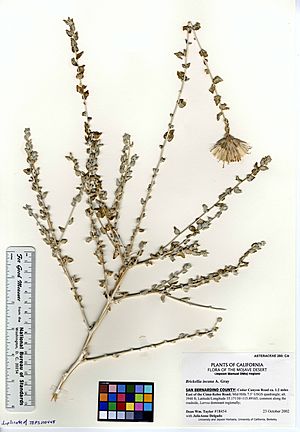Woolly brickellbush facts for kids
Quick facts for kids Woolly brickellbush |
|
|---|---|
 |
|
| herbarium specimen collected in San Bernardino County, California |
|
| Scientific classification | |
| Kingdom: | |
| (unranked): | |
| (unranked): | |
| (unranked): | |
| Order: | |
| Family: | |
| Subfamily: |
Asteroideae
|
| Tribe: |
Eupatorieae
|
| Genus: |
Brickellia
|
| Species: |
B. incana
|
| Binomial name | |
| Brickellia incana |
|
| Synonyms | |
|
Coleosanthus incanus (A.Gray) Kuntze |
|
Brickellia incana, also known as the woolly brickellbush, is a type of flowering plant found in North America. It belongs to the daisy family, which includes many common flowers like sunflowers and daisies. This plant grows naturally in the dry Mojave Desert and Sonoran Desert regions of the southwestern United States. You can find it in states like California, Nevada, and Arizona.
About the Woolly Brickellbush
The woolly brickellbush is a shrub, which means it's a woody plant smaller than a tree. It often grows in a round shape, like a ball, right on the sandy desert ground. These plants usually reach a height of about 40 centimeters (about 1.3 feet) to 1 meter (about 3.3 feet) tall.
What Does It Look Like?
The leaves of the woolly brickellbush are a special feature. They are a grayish-green color, sometimes even appearing white. This is because they are covered with a thin layer of soft, woolly fibers, which helps the plant survive in the desert. The leaves are oval-shaped and can grow up to 3 centimeters (about 1.2 inches) long.
Flowers and Fruit
The plant produces single flower heads at the end of its branches. Each flower head is about 2.4 centimeters (about 1 inch) long. They are surrounded by special leaf-like structures called phyllaries, which are also woolly and can be gray-green or grayish-purple.
Inside each flower head, you'll find about 60 small flowers called disc florets. These tiny flowers can be red, yellowish, or grayish. After the flowers bloom, the plant produces a fruit called an achene. This fruit is hairy and shaped like a cylinder, about a centimeter long. It has a pappus, which is a tuft of bristles that helps the seeds float away on the wind, spreading the plant to new places.

